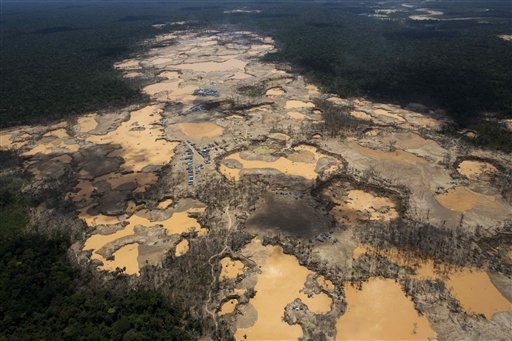500,000 miners exposed to mercury, study shows
Change Size
 This Nov. 11, 2014 file photo shows a deforested area dotted with blue tarps, marking the area where miners reside, and craters filled with water, caused by illegal gold mining activities, in La Pampa, in Peru's Madre de Dios region. Peru’s government has declared an emergency across a broad jungle region because of mercury contamination, much of it caused by wildcat gold mining. The 60-day decree issued Monday affects 11 districts in the Madre de Dios region where studies have found high levels of the toxic element in people, rivers and fish. (AP/Rodrigo Abd)
This Nov. 11, 2014 file photo shows a deforested area dotted with blue tarps, marking the area where miners reside, and craters filled with water, caused by illegal gold mining activities, in La Pampa, in Peru's Madre de Dios region. Peru’s government has declared an emergency across a broad jungle region because of mercury contamination, much of it caused by wildcat gold mining. The 60-day decree issued Monday affects 11 districts in the Madre de Dios region where studies have found high levels of the toxic element in people, rivers and fish. (AP/Rodrigo Abd)
A
bout 500,000 traditional miners, including 100,000 women and children, are exposed to the highly toxic mercury, a recent survey shows.
Bali Fokus’ research in Sekotong, West Nusa Tenggara, and Paboyo in Central Sulawesi, found that the dangerous chemical is widely used to amalgamate gold. There, the risky process is done in people’s backyards and on their farms. Miners also use cyanide and directly dump the waste into rivers.
“Some women even use fireplaces in their kitchen to help their husband amalgamate gold,” Toxic Program Manager of Bali Fokus Foundation, Krishna Zaki, said in Jakarta on Wednesday.
A separate study by the Biodiversity Research Institute on traditional mining communities in Sekotong, West Nusa Tenggara, and in Paboyo, Central Sulawesi, in 2012 showed that the mercury levels in people’s blood exceeded the safe standard.
The average mercury level at both communities was recorded at 4.32 ppm. with 1 ppm being the most tolerable level and 10 ppm as the highest level of exposure to mercury.
Bali Fokus found that several new born babies and children in the surveyed communities showed signs of neurological disorder, cerebral palsy, and deformity, among other things.
“We have not been able to check the levels of chemical substances in all of the kids' blood but among some of the children we did find traces of mercury,” Krishna said.
The Health Ministry, which has embarked on a national action plan on mercury exposure, admitted that it still lacked vital facilities for detection and early diagnoses of mercury-related health issues.
“Our biomonitoring facilities for detecting the mercury exposure in the blood system are available only in several big cities in Sumatra an Java,” Inne Nurfiliana of the ministry said, noting that the situation was precarious because most of the mining communities live in rural areas.
The ministry reckons that costly diagnosis was a major issue. A single check on the amount of metal amount in one’s blood using the biomonitoring system costs between Rp 300,000 and Rp 600,000.
“It’s hard to stop the use of mercury because a lot of people depend on it for their livelihood,” Purwasto Saroprayogi of the Environment and Forestry Ministry said. Furthermore, most traditional miners obtain it from the black market.
This year the Ministry is planning to begin pilot projects in Lebak, Banten; Banyumas, Central Java, and Pacitan, East Java, for gold processing with gold cyanidation, instead of mercury.
While the level of toxicity of cyanide is still unknown, Purwasto assured that with a closed management system it would be less dangerous than mercury.
“To control the use of mercury, we have to control small-scale miners,” Purwanto said.
The ministry’s short-term plan would be to organize the small scale miners under the People’s Mining Zoning scheme. (hol)









